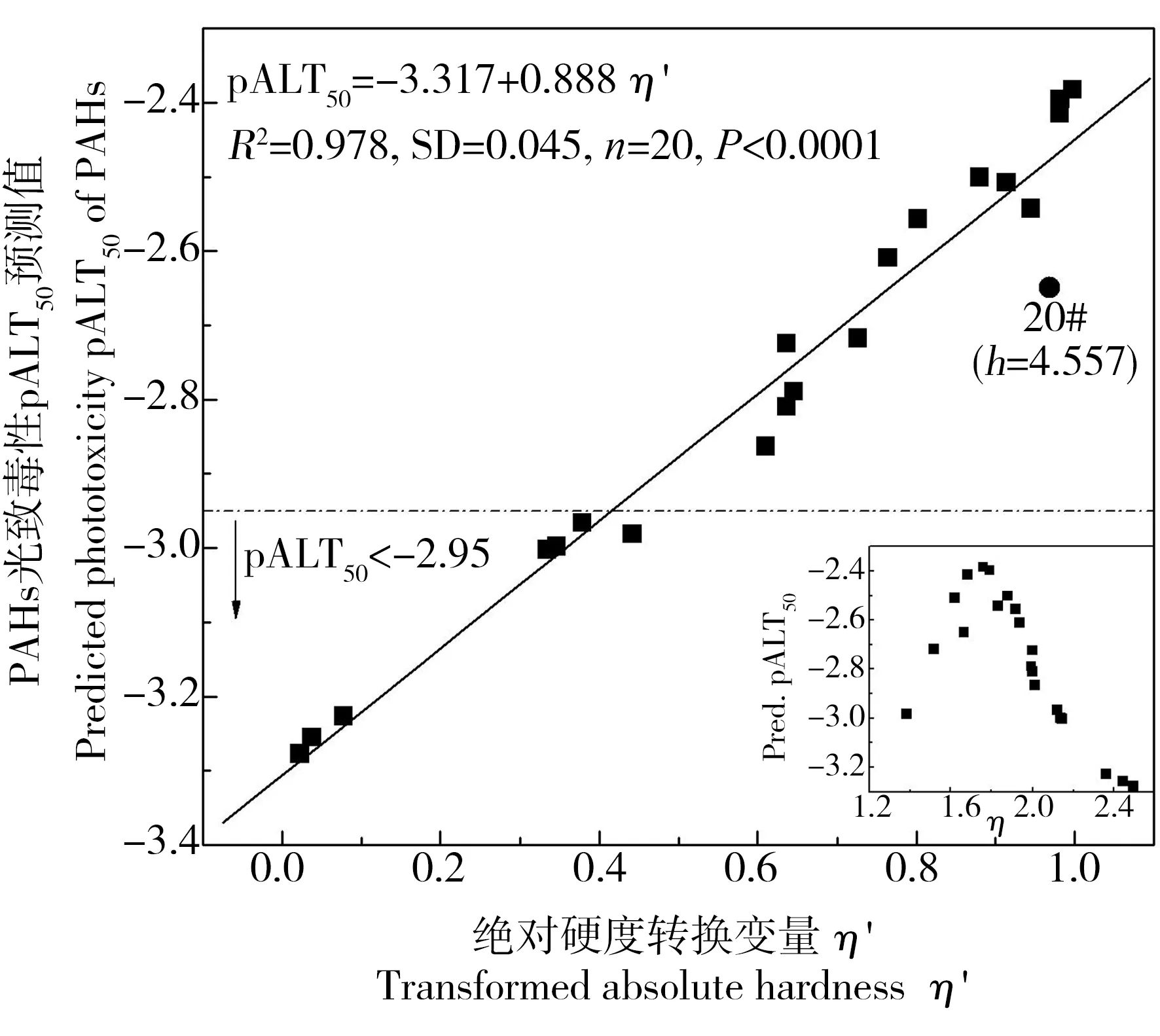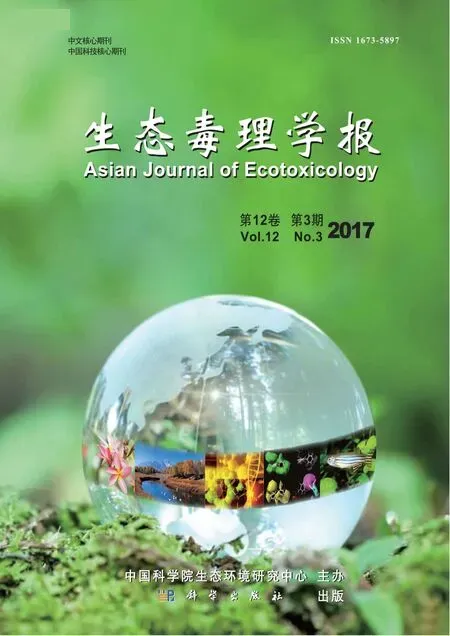多環芳烴典型電子性質與其大型蚤光致毒性的構效關系研究
谷成剛,朱夢榮, 2,劉暢, 2,提清清, 2,何歡,孫成, #,蔣新, *
1. 中國科學院南京土壤研究所,土壤環境與污染修復重點實驗室,南京 2100082. 中國科學院大學,北京 1000493. 南京大學環境學院,污染控制與資源化研究國家重點實驗室,南京 210023
多環芳烴典型電子性質與其大型蚤光致毒性的構效關系研究
谷成剛1,朱夢榮1, 2,劉暢1, 2,提清清1, 2,何歡3,孫成3, #,蔣新1, *
1. 中國科學院南京土壤研究所,土壤環境與污染修復重點實驗室,南京 2100082. 中國科學院大學,北京 1000493. 南京大學環境學院,污染控制與資源化研究國家重點實驗室,南京 210023
多環芳烴(PAHs)是環境中廣泛分布的持久性有毒有機污染物,備受研究者關注。基于密度泛函理論(DFT)先期計算PAHs前線分子軌道能隙可能與其光致毒性誘發所需吸收光照輻射能有一致性,本研究選取非取代PAHs對大型蚤(Daphnia magna)光致毒性實驗數據,通過DFT計算典型電子性質,由偏最小二乘(PLS)分析方法優化發展了定量構效關系模型,經與前人結果比較和驗證其擬合優度、穩定性和內外部預測性能均有顯著提升,可在應用域(AD)范圍內準確預測PAHs光致毒性而滿足風險評估需求。構效關系分析結果表明,PAHs光致毒性與分子前線軌道能隙緊密相關,除苯并[k]熒蒽和屈可能具有不同的光致毒性作用機制之外,多數PAHs若具有較低的前線軌道能隙、較小分子穩定性和較大分子變形性,均將有利于促進其光致毒性作用的發生;結合PAHs光致毒性與分子前線軌道能隙間的相關關系,可推測DFT計算前線軌道能隙寬度在2.740~4.208 eV之間和對應光照輻射波段約為295 nm~450 nm時,PAHs污染暴露將可能誘發較高的光致毒性效應。這為太陽光照射下PAHs光致毒性作用機制闡釋和風險評價提供了數據支持與理論依據。
多環芳烴;大型蚤;光致毒性;密度泛函理論方法;電子性質;構效關系
Received3 January 2017accepted8 March 2017
Abstract: Polycyclic aromatic hydrocarbons (PAHs) pertain to the category list of persistent toxic substances which are ubiquitously detected in the environment and thereby arouse much concerns of scientific community. Based on the possible coherence of solar irradiation with the energy gap of molecular frontier orbitals by preliminary computation of density functional theory (DFT), in this study the experimental phototoxicity of PAHs to Daphnia magna was selected in priori, and the corresponding quantitative structure-activity relationship (QSAR) between the typically DFT-calculated electronic properties and phototoxicity was carefully developed by partial least square (PLS) analyses. After critical validation and comparison with previous studies, the goodness of fitting, robustness and internal or external predictability was clearly enhanced to a certain degree. Thus, within the decided applicability domain (AD) the QSAR was suggested to serve as precise prediction tool to meet the demand of risk assessment. QSAR analysis indicated the tight correlation relationship of phototoxicity with energy gap of molecular frontier orbitals. And with the exception of benzo[k]fluoranthene and chrysene for different photoinduced toxicological mechanism, it is suitable for the great majority of PAHs that the lower energy gap of molecular frontier orbitals, the less molecular stability and higher deformability shall favor the occurrence of phototoxicity. In virtue of the correlation between energy gap of frontier orbitals and phototoxicity, the span of energy gap 2.740-4.208 eV by DFT and the predicted corresponding wave spectrum of solar irradiation within about 295 nm-450 nm was proposed as the necessity of PAHs exposure to induce the higher phototoxicity. The study could be anticipated for providing data framework and theoretical guideline for phototoxicological mechanism illumination and risk assessment of PAHs under solar irradiation.Keywords: PAHs; Daphnia magna; phototoxicity; density functional theory; electronic properties; QSARs
多環芳烴(PAHs)是由2個及2個以上的苯環以稠環方式相連接的化合物,主要來自于石油、煤炭等人類工業活動所需材料的不完全燃燒和火山噴發、森林火災以及高等植物的合成釋放等天然因素,在生物與非生物環境介質中均有分布[1-4]。由于PAHs具有典型的致癌、致畸、致突變“三致”效應、生殖毒性和環境持久性[5-8],已成為威脅生態系統安全和人體健康的重要有機污染物,其早在20世紀80年代就被美國環境保護署(EPA)同等列為優先控制污染物中的一類[9],一直以來備受各國研究者的普遍關注。
PAHs因其稠環電子結構形成共軛大Π鍵,能夠在光照作用下吸收可見或紫外光波段而引發一系列的光化學反應,如通過光修飾作用轉化為毒性更大的產物,或通過生成自由基、單線態氧而造成對各種生物大分子(如核酸、脂質或蛋白質等)的損傷,整體表現出光致毒性。于20世紀中期,就有研究指出PAHs對哺乳動物、水生生物等都能表現出光致毒性效應[10],而后續的研究也逐漸深入廣泛,開展了以大型蚤(Daphnia magna)[11-14]、發光菌(Vibrio fischeri)[15-16]和綠藻(Scenedesmus vacuolatus)[17]等為指示生物的實驗研究,提出了相應的光致毒性作用機制,為PAHs的生物效應和風險評估提供了科學依據。研究表明,在120 μW·cm-2的UV-A(320 nm~400 nm)和25 μW·cm-2的UV-B(290 nm~320 nm)紫外輻射作用下,PAHs,如蒽能夠與DNA大分子共價結合而誘發對典型水生生物-大型蚤(Daphnia magna)的光致毒性效應[11, 18]。為進一步揭示光致毒性作用機制,前人已從PAHs電子結構和分子光譜特征等參數化表征出發,發展了與其光致毒性之間的定量構效關系(QSARs),并在光敏化和光修飾因子的基礎上提出了雙向作用機制[19-22]。Newsted等[11]基于雜原子取代和非取代PAHs對大型蚤的光致急性毒性,以最低單重激發態和三重激發態能量發展了非線性構效關系。兼顧PAHs對光的吸收效率、水溶液中穩定性、輻射源能量與光照密度等因素間的競爭關系,Mekenyan等[23]在半經驗分子軌道計算方法AM1和PM3結構優化的基礎上,探討了分子前線軌道能隙(EGAP)與大型蚤光致毒性間的相關關系,繼而修正了非線性構效關系,并預測PAHs分子前線軌道能隙在7.2±0.4 eV時,可誘發對大型蚤的光致毒性。由于PAHs分子前線軌道能隙寬時,能量足夠大的光子才有可能激發前線分子軌道的電子發生躍遷、引發光化學反應而表現出光致毒性,然而(模擬)太陽光照的紫外短波段可能無法接觸環境界面,實際引發PAHs的光致毒性并不顯著;相比之下,PAHs分子前線軌道能隙窄時,分子穩定性差、易降解,實際引發PAHs的光致毒性也較小。為此,Ferreira[24]建立了PAHs分子前線軌道能隙與其光致毒性的Gaussian型函數關系,并在后來將分子前線軌道能隙寬度由7.2±0.4 eV擴大到7.2±0.7 eV用于預測大型蚤光致毒性[25]。分子前線軌道能隙是外層電子發生躍遷和轉移的屏障,是分子穩定性和反應性的電子結構基礎。然而,比較不同PAHs光致毒性效應所對應的光照輻射波長(小于5.0 eV)和半經驗分子軌道計算方法AM1計算的前線軌道能隙,可發現AM1計算前線軌道能隙接近光照輻射能量的2倍,如表1,這可能源于電子相關處理的缺失。相對而言,密度泛函理論方法(DFT)能夠以泛函形式考量電子相關問題,先期計算結果表明,DFT計算PAHs分子前線軌道能隙和光致毒性效應所對應的光照輻射能量是相近的(見表1)。因此,基于DFT對PAHs電子結構和能量計算表征,減少半經驗分子軌道計算方法帶來的誤差,可能有助于提高PAHs光致毒性構效關系及其預測準確性。
本文利用DFT三參數混合泛函理論方法對PAHs電子結構優化計算,并在基態電子結構與能級參數Gaussian型函數關系轉化的基礎上,由偏最小二乘分析(PLS)方法[26-27]優化發展PAHs對大型蚤(Daphnia magna)[23]光致毒性效應的定量構效關系,以期在相關模型內外部預測性能得以顯著提升的前提下,在相似結構應用域(AD)內用于準確預測PAHs光致毒性效應并闡釋相關分子作用機制。相關工作開展,將為PAHs水生生態光致毒性效應評價提供數據基礎和科學依據。
1 材料與方法(Materials and methods)
1.1 PAHs電子結構優化計算


(1)

表1 PAHs光吸收能量與不同前線軌道能隙的比較Table 1 Comparison between the absorbed solar energy and the calculated energy gap of frontier orbitals of PAHs by AM1 and DFT respectively
注:PAHs對大型蚤光致毒性的實測吸收波長和AM1計算PAHs的EGAP分別來自文獻[11, 25];所采納DFT計算方法為B3LYP/6-311G**。
Note: Data of wave length absorbed for PAHs phototoxicity to Daphnia magna, and EGAPcomputed by AM1 referenced from [11, 25]; DFT method was employed as B3LYP/6-311G**.
η=(ELUMO-EHOMO)/2=EGAP/2
(2)
絕對硬度(η)表示分子體系的穩定性和反應進行的難易程度:η越大,分子越“硬”,電子從最高占有軌道向最低未占軌道的躍遷和電子轉移越不容易發生;反之,分子體系越“軟”,電子躍遷越容易發生[35]。有研究表明,絕對硬度與分子極化率具有一定相關性,反映了分子在外加電場下外層電子云的變形性[37-38]。PAHs在光照輻射或與生物受體分子作用時,電子轉移的潛勢可由電子轉移量予以表征,因此分子體系能量下降最大化情況下的電子轉移量,即最大電子轉移量(ΔNmax)可由式(3)計算求得。
ΔNmax=(ELUMO+EHOMO)/(EHOMO-ELUMO)
(3)
考慮PAHs電子性質參數在后續構效關系中的統計學顯著性,主要將電子軌道能級和絕對硬度及其相關參數列于表2。
1.2 數據來源與模型建立方法
為對比研究PAHs對大型蚤光致毒性的分子前線軌道能隙預測寬度,本文選取17種非取代PAHs對水生生物-大型蚤(Daphnia magna)光致毒性實驗數據(Exp.)[23],以調整半數致死時間ALT50(S)為毒理學指標,表示為對數形式-logALT50(pALT50)。pALT50越大,PAHs對大型蚤的光致毒性效應越顯著。相關數據見表2。

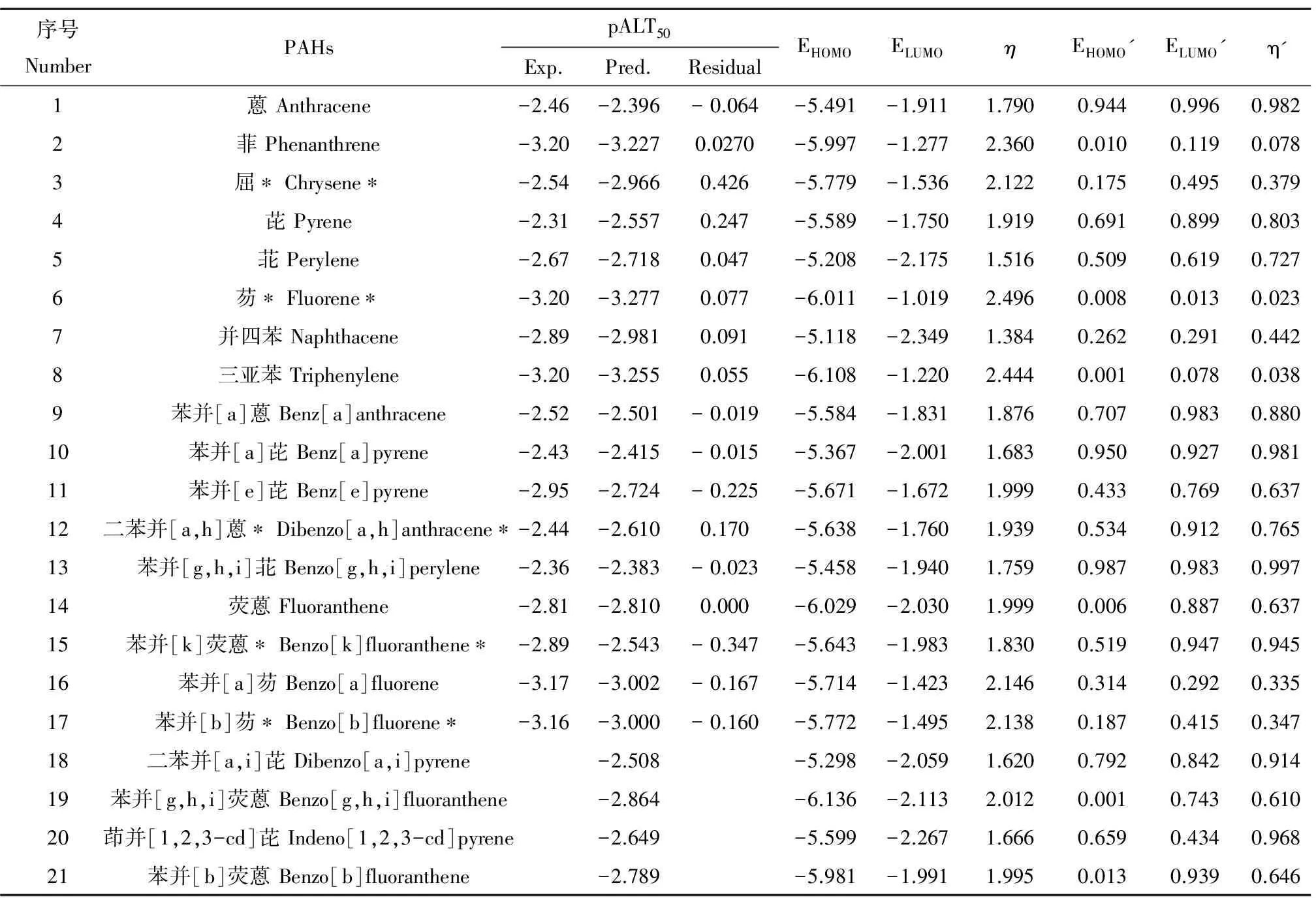
表2 PAHs電子性質參數及其光致毒性實測、預測值和相關殘差Table 2 PAHs electronic properties, and the experimental, predicted and residuals of corresponding phototoxicity
注:*標示為PAHs光致毒性構效關系的測試集;PAHs電子性質參數單位:eV。
Note: Test set labeled by asterisks for QSAR of PAHs phototoxicity; Electronic properties of PAHs in eV.
(4)


(5)


2 結果(Results)
2.1 PAHs前線軌道能級/能隙與光致毒性的相關性

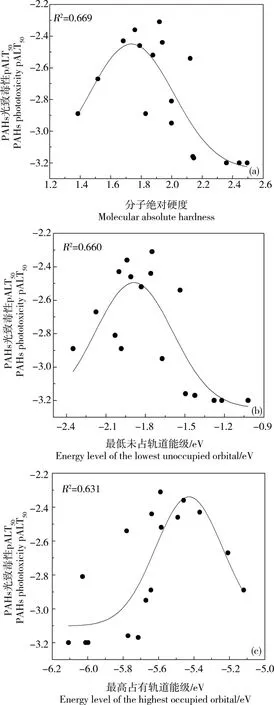
圖1 PAHs大型蚤光致毒性與前線軌道能級/能隙的相關性Fig. 1 Correlation between energy levels/energy gap of frontier molecular orbitals and phototoxicity of PAHs to Daphnia magna
pALT50= -3.291 +0.336η' +0.299E'LUMO+0.283E'HOMO
(6)


圖2 PAHs大型蚤光致毒性預測值與實測值的比較關系Fig. 2 Comparisons between the predicted and experimental phototoxicity of PAHs to Daphnia magna
構效關系的應用域AD表征如圖3所示。由圖可以看出,PAHs電子結構信息的杠桿值h均小于臨界h*(1.0),說明構效關系模型在具有相似稠環結構的應用域內能夠準確預測PAHs的光致毒性,且熒蒽(14#)相較而言具有較高的杠桿值,屬于高杠桿樣本點,表明其四元環分子結構信息對構效關系發展具有顯著影響。就預測殘差而言,95%置信區間內所有PAHs光致毒性的預測殘差絕對值均低于2.5δ,說明構效關系能夠給予相對準確的PAHs光致毒性預測值。若究其嚴格的±2δ標準化殘差區間,屈(3#)和苯并[k]熒蒽(15#)將分別界定于殘差區間之外,分別屬于被低估和高估的奇異值。然而,就PAHs光致毒性相關構效關系的預測性能而言,在±2.5δ標準化殘差區間范圍內其準確性在總體上仍可以滿足風險評估的具體需求。

圖3 PAHs光致毒性Williams圖Fig. 3 Williams plot sketched for phototoxicity of PAHs
2.2 PAHs光致毒性構效關系的性能比較

3 討論(Discussion)
為定量評估PAHs電子性質參數對其光致毒性變異解釋的貢獻和相對大小,計算了電子性質參數在PLS提取主成分上的相對權重(W*)及其VIPs值。本研究構效關系引入并保留了3個性質參數,其在第一主成分上的相對權重W*和VIPs參見柱狀圖4。與分子絕對硬度有關的η'具有最大權重(0.603)和最高VIP(1.04),結合光致毒性與η'之間的正相關關系,即較高的η'能夠誘發較高的光致毒性,表明PAHs基態分子的前線軌道能隙和分子穩定性對PAHs光致毒性具有重要影響,只是影響關系并非線性;盡管有較高前線軌道能隙和分子穩定性的PAHs能夠誘發光致毒性效應,但對于大多數PAHs化合物而言,在一定范圍內較小的前線軌道能隙和較低的分子穩定性,才能促使光致毒性發生,這可能是由于PAHs較小的前線軌道能隙有利于光照能量的吸收而發生光敏化反應。由于絕對硬度與分子的極化率、分子體積具有一定相關性[37-38],絕對硬度越小、極化率和分子體積越大,核外電子在外加或鄰近分子電場作用下的變形性越大,使得分子正、負電荷重心不斷發生瞬間相對位移并產生瞬間偶極,從而愈發有利于非極性或極性分子之間的瞬間偶極-瞬間偶極相互吸引作用,即色散作用。這與前人分析結果具有較好的一致性[46]。相比之下,E'LUMO和E'HOMO的權重(W*,0.568和0.560)和VIP(0.98,0.97)略小;由于ELUMO和EHOMO分別與前線分子軌道得失電子有關,其包涵的電子結構能級排布特征信息,在一定程度上可與前線軌道能隙緊密相關。
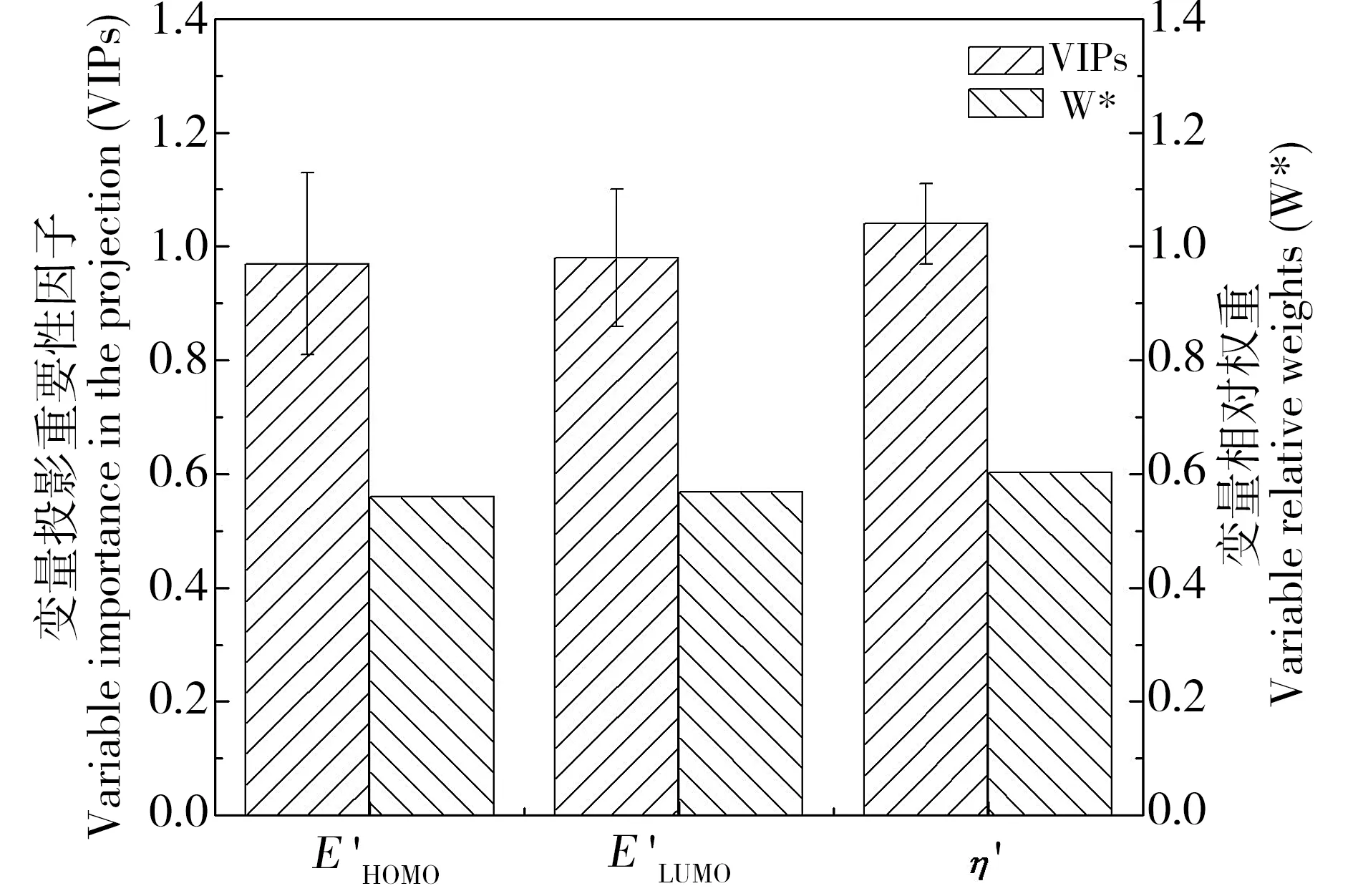
圖4 PAHs電子性質參數的相對權重與VIPs比較Fig. 4 Comparisons of relative weights and VIPs among electronic properties of PAHs
前人分別根據PAHs光致毒性的預測值與實測值,將PAHs劃分為高等、中等和低等光致毒性暴露污染物,如菲、芴和三亞苯具有相對較低的光致毒性,其調整半數致死時間pALT50遠小于-2.95[23, 25]。因此,pALT50等于-2.95成為定量評估PAHs光致毒性大小的“分水嶺”,大于該值則表明PAHs能夠誘發較高或中等光致毒性。以本研究所取得構效關系對非取代PAHs光致毒性進行預測(表2),且將預測值與轉換絕對硬度η'進行線性擬合,得到擬合方程。由于茚并[1,2,3-cd]芘(20#)電子結構杠桿值h較大(4.557),表明其與其他PAHs化合物的結構信息質點距離較遠,電子結構具有較大的差異。為此,在排除20#化合物的基礎上,PAHs光致毒性預測值與η'的線性相關性由原來的R2為0.956提高到0.978,如圖5所示。當pALT50大于-2.95時,可以計算出相對高毒性PAHs所對應的絕對硬度η區間,即1.370 eV<η<2.104 eV,對應前線軌道能隙值區間2.740 eV 圖5 PAHs大型蚤光致毒性預測值與分子絕對硬度 間的相關關系Fig. 5 Correlation relationship between molecular hardness and predicted pALT50 of PAHs to Daphnia magna 綜上所述,基于DFT理論方法發展的PAHs對大型蚤光致毒性的構效關系,其擬合優度、穩定性和內外部預測性能均有顯著提升,可在應用域范圍內準確預測PAHs光致毒性,從而滿足風險評估需求。構效關系分析結果表明,除苯并[k]熒蒽和屈可能具有不同的光致毒性作用機制之外,對于多數PAHs而言,若具有較低的前線軌道能隙、較小的分子穩定性和較大的分子變形性,均將有利于促使光致毒性作用的發生;且DFT計算PAHs前線軌道能隙寬度在[2.740,4.208]eV之間和對應光照輻射波段約為295 nm~450 nm時,PAHs污染暴露將可能誘發較高的光致毒性效應。這為PAHs對大型蚤光致毒性作用機制闡釋和風險評價提供了數據支持與理論依據。 [1] Gewurtz S B, Lazar R, Haffiner G D. Comparison of polycyclic aromatic hydrocarbon and polychlorinated biphenyl dynamics in benthic invertebrates of Lake Erie, USA [J]. Environmental Toxicology and Chemistry, 2000, 19: 2943-2950 [2] White J C, Triplett T. Polycyclic aromatic hydrocarbons (PAHs) in the sediments and fish of the Mill River, New Haven, Connecticut, USA[J]. Bulletin of Environmental Contamination and Toxicology, 2002, 68: 104-110 [3] Liang Y, Tse M F, Young L, et al. Distribution patterns of polycyclic aromatic hydrocarbons (PAHs) in the sediments and fish at Mai Po Marshes Nature Reserve, Hong Kong [J]. Water Research, 2007, 41: 1303-1311 [4] Wang Z, Chen J, Qiao X, et al. Distribution and sources of polycyclic aromatic hydrocarbons from urban to rural soils: A case study in Dalian, China [J]. Chemosphere, 2007, 68: 965-971 [6] Lin C C, Chen S J, Huang K L, et al. PAHs, PAH-induced carcinogenic potency, and particle-extract-induced cytotoxicity of traffic-related nano/ultrafine particles [J]. Environmental Science and Technology, 2008, 42: 4229-4235 [7] Maertens R M, Gagne R W, Douglas G R, et al. Mutagenic and carcinogenic hazards of settled house dust II: Salmonella mutagenicity [J]. Environmental Science and Technology, 2008, 42: 1754-1760 [8] Papa E, Pilutti P, Gramatica P. Prediction of PAH mutagenicity in human cells by QSAR classification [J]. SAR and QSAR in Environmental Research, 2008, 19: 115-127 [9] Callahan M A, Slimak M W, Gabel N W, et al. Water-related environmental fate of 129 priority pollutants, EPA-440/4-79-029B [R]. Washington DC: U S Environmental Protection Agency, 1979 [10] Santamaria L, Prino G. The photodynamic substances and their mechanism of action [J]. Research Progress in Organic-Biological and Medicinal Chemistry, 1964, 1: 259-336 [11] Newsted J L, Giesy J P. Predictive models for photoinduced acute toxicity of polycyclic aromatic-hydrocarbons to Daphnia magna, Strauss (Cladocera, crustacea) [J]. Environmental Toxicology and Chemistry, 1987, 6: 445-461 [12] Wernersson A S, Dave G. Phototoxicity identification by solid phase extraction and photoinduced toxicity to Daphnia magna [J]. Archives of Environmental Contamination and Toxicology, 1997, 32: 268-273 [13] Huovinen P S, Soimasuo M R, Oikari A O J. Photoinduced toxicity of retene to Daphnia magna under enhanced UV-B radiation [J]. Chemosphere, 2001, 45: 683-691 [14] Lampi M A, Gurska J, McDonald K I C, et al. Photoinduced toxicity of polycyclic aromatic hydrocarbons to Daphnia magna: Ultraviolet-mediated effects and the toxicity of polycyclic aromatic hydrocarbon photoproducts [J]. Environmental Toxicology and Chemistry, 2005, 25: 1079-1087 [15] McConkey B J, Duxbury C L, Dixon D G, et al. Toxicity of a PAH photooxidatin product to the bacteria Photobacterium phosphoreum and the duckweed Lemna gibba: Effects of phenanthrene and its primary photoproduct, phenanthrenequinone [J]. Environmental Toxicology and Chemistry, 1997, 16: 892-899 [16] El-Alawi Y S, Dixon D G, Greenberg B M. Effects of a pre-incubation period on the photoinduced toxicity of polycyclic aromatic hydrocarbons to the luminescent bacterium Vibrio fischeri [J]. Environmental Toxicology, 2001, 16: 277-286 [17] Grote M, Schüürmann G, Altenburger R. Modelling photoinduced algal toxicity of polycyclic aromatic hydrocarbons [J]. Environmental Science and Technology, 2005, 39: 4141-4149 [18] Sina B K, Chignell C F. Binding of anthracene to cellular macromolecules in presence of light[J]. Photochemistry and Photobiology, 1983, 37: 33-37 [19] Huang X D, Krylov S N, Ren L S, et al. Mechanistic quantitative structure-activity relationship model for the photoinduced toxicity of polycyclic aromatic hydrocarbons. II. An empirical model for the toxicity of 16 polycyclic aromatic hydrocarbons to the duckweed Lemna gibba L. G-3 [J]. Environmental Toxicology and Chemistry, 1997, 16: 2296-2303 [20] El-Alawi Y S, Huang X D, Dixon D G, et al. Quantitative structure-activity relationship for the photoinduced toxicity of polycyclic aromatic hydrocarbons to the luminescent bacteria Vibrio fischeri [J]. Environmental Toxicology and Chemistry, 2002, 21: 2225-2232 [21] Lampi M A, Gurska J, Huang X D, et al. A predictive quantitative structure-activity relationship model for the photoinduced toxicity of polycyclic aromatic hydrocarbons to Daphnia magna with the use of factors for photosensitization and photomodification [J]. Environmental Toxicology and Chemistry, 2007, 26: 406-415 [22] Zhang Q. Predictive models on photolysis and photoinduced toxicity of persistent organic chemicals [J]. Frontiers of Environmental Science and Engineering, 2013, 7(6): 803-814 [23] Mekenyan O G, Ankley G T, Veith G D, et al. QSARs for photoinduced toxicity: I. Acute lethality of polycyclic aromatic hydrocarbons to Daphnia magna [J]. Chemosphere, 1994, 28: 567-582 [24] Ferreira M. Polycyclic aromatic hydrocarbons: A QSPR study [J]. Chemosphere, 2001, 44: 125-146 [25] Ribeiro F, Ferreira M. QSAR model of the phototoxicity of polycyclic aromatic hydrocarbons [J]. Journal of Molecular Structure: THEOCHEM, 2005, 719: 191-200 [26] Wold S, Albano C, Dunn W J, et al. Multivariate Data Analysis in Chemistry [M]// Kowalski B. (Ed.). Chemometrics: Mathematics and Statistics in Chemistry. Reidel, Dordrecht, 1984: 17-95 [27] Geladi P. Notes on the history and nature of partial least squares (PLS) modeling [J]. Journal of Chemometrics, 1988, 2: 231-246 [28] Lee C, Yang W, Parr R G. Development of the Colle-Salvetti correlation-energy formula into a functional of the electron density [J]. Physical Review B, 1988, 37: 785-789 [29] Becke A D. Density-functional thermochemistry.Ⅲ. The role of exact exchange [J]. Journal of Chemical Physics, 1993, 98: 5648-5652 [30] Peng C, Ayala P Y, Schlegel H B, et al. Using redundant internal coordinates to optimize geometries and transition states [J]. Journal of Computational Chemistry, 1996, 17: 49-54 [31] Peng C, Schlegel H B. Combining synchronous transit and Quasi-Newton methods for finding transition states [J]. Israel Journal of Chemistry, 1994, 33(4): 449-454 [32] Frisch M J, Trucks G W, Schlegel H B, et al. Gaussian 03, Revision B.03 [CP]. Pittsburgh PA: Gaussian Inc., 2003 [33] Mhin B J, Lee J E, Choi W. Understanding the congener-specific toxicity in polychlorinated dibenzo-p-dioxins: Chlorination pattern and molecular quadrupole moment [J]. Journal of the American Chemical Society, 2002, 124:144-148 [34] Cammarata A. An apparent correlation between the in vitro activity of chloramphenicol analogs and electronic polarizability [J]. Journal of Medicinal Chemistry, 1967, 10: 525-527 [35] Parr R G, Pearson R G. Absolute hardness: Companion parameters to absolute electronegativity [J]. Journal of the American Chemical Society, 1983, 105: 7512-7516 [36] Koopmans T. über die Zuordnung von Wellenfunktionen und Eigenwerten zu den Einzelnen Elektronen Eines Atoms [J]. Physica, 1934, 1: 104-113 [37] Politzer P A. A relationship between the charge capacity and the hardness of neutral atoms and groups [J]. Journal of Chemical Physics, 1987, 86: 1072-1073 [38] Ghanty T K, Ghosh S K. Correlation between hardness, polarizability, and size of atoms, molecules, and clusters [J]. Journal of Physical Chemistry, 1993, 97: 4951-4953 [39] Alexander G, Alexander T. Beware of Q2[J]. Journal of Molecular Graphics and Modelling, 2002, 20: 269-276 [40] Luco J M. Prediction of the brain-blood distribution of a large set of drugs from structurally derived descriptors using partial least-squares (PLS) modeling [J]. Journal of Chemical Information and Computer Science, 1999, 39: 396-404 [41] Eriksson L, Jaworska J, Worth A P, et al. Methods for reliability and uncertainty assessment and for applicability evaluation of classification- and regression-based QSARs [J]. Environmental Health Perspectives, 2003, 111(10):1361-1375 [42] Gramatica P. Principles of QSAR models validation: Internal and external [J]. QSAR & Combinatorial Science, 2007, 26(5): 694-701 [43] Roy K, Kar S, Ambure P. On a simple approach for determining applicability domain of QSAR models [J]. Chemometrics and Intelligent Laboratory Systems, 2015, 145: 22-29 [44] Klopman G, Kalos A N. Causality in structure-activity studies [J]. Journal of Computational Chemistry, 1985, 6: 492-506 [46] Wang Y, Chen J W, Li F, et al. Modelling photoinduced toxicity of PAHs based on DFT-calculated descriptors [J]. Chemosphere, 2009, 76(7): 999-1005 ◆ InvestigationofStructure-ActivityRelationshipbetweenTypicalElectronicPropertiesandPhototoxicityofPolycyclicAromaticHydrocarbonstoDaphniamagna Gu Chenggang1, Zhu Mengrong1,2, Liu Chang1,2, Ti Qingqing1,2, He Huan3, Sun Cheng3, #, Jiang Xin1, * 1. Key Laboratory of Soil Environment and Pollution Remediation, Institute of Soil Science, Chinese Academy of Sciences, Nanjing 210008, China2. University of Chinese Academy of Sciences, Beijing 100049, China3. State Key Laboratory of Pollution Control and Resource Reuse, School of the Environment, Nanjing University, Nanjing 210023, China 10.7524/AJE.1673-5897.20170103003 2017-01-03錄用日期2017-03-08 1673-5897(2017)3-516-10 X171.5 A 蔣新(1961—), 博士,研究員, 主要研究方向為典型持久性有機污染物的土壤環境化學行為與污染控制, 發表中英和德文學術論文190余篇。 國家自然科學基金項目(21377138;51578279);國家重點基礎研究發展計劃(2014CB441105);中科院“一三五”計劃和領域前沿項目(ISSASIP1618)資助 谷成剛(1979-),男,博士,研究方向為土壤環境化學,E-mail: cggu@issas.ac.cn *通訊作者(Corresponding author), E-mail: jiangxin@issas.ac.cn #共同通訊作者(Co-corresponding author), E-mail: envidean@nju.edu.cn 谷成剛, 朱夢榮, 劉暢, 等. 多環芳烴典型電子性質與其大型蚤光致毒性的構效關系研究[J]. 生態毒理學報,2017, 12(3): 516-525 Gu C G, Zhu M R, Liu C, et al. Investigation of structure-activity relationship between typical electronic properties and phototoxicity of polycyclic aromatic hydrocarbons to Daphnia magna [J]. Asian Journal of Ecotoxicology, 2017, 12(3): 516-525 (in Chinese)